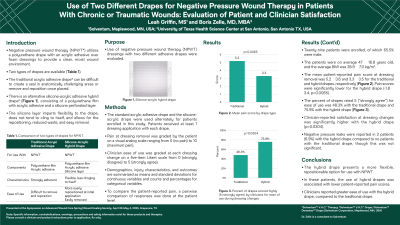Health Economics
(HE-004) Use of Two Different Drapes for Negative Pressure Wound Therapy in Patients with Chronic or Traumatic Wounds: Evaluation of Patient and Clinician Satisfaction
Friday, May 2, 2025
7:45 PM - 8:45 PM East Coast USA Time

Boris Zelle, MD; MBA
Introduction: The use of negative pressure wound therapy (NPWT) dressings with two different adhesive drapes (traditional acrylic adhesive drape* and silicone-acrylic adhesive hybrid drape†) was evaluated. The aim of the study was to compare patient and clinician satisfaction between the two drapes.
Methods: In this exploratory prospective study, patients with chronic or traumatic wounds treated with NPWT using either traditional or hybrid drape were assessed. Only patients that required a minimum of 2 NPWT dressing changes at the bedside were eligible for inclusion. Patients received at least 1 dressing application with each drape. Pain at dressing removal was graded by the patient on a visual analogue scale ranging from 0 (no pain) to 10 (maximum pain). Clinician ease of use was graded at each dressing change on a five-item Likert scale from 0 (strongly disagree) to 5 (strongly agree).
Results: Twenty-nine patients were enrolled. The mean pain score at dressing removal was 3.3 ± 3.5 and 5.2 ± 3.6 for the hybrid and traditional drapes, respectively. Therefore, patient reported pain scores at drape removal were significantly lower for the hybrid drape ( -1.8 ± 3.4, p=0.0065). Clinician reported satisfaction was significantly higher with the hybrid drape (76.9% versus 48.3% for rating 5=strongly agree, p=0.0304). Negative pressure leaks were reported in 2 patients (6.9%) with the hybrid drape compared to no patients with the traditional drape, though this difference was not significant.
Discussion: In these patients, reduced patient reported pain at drape removal and increased clinician reported ease of use was observed with the hybrid drape.
Methods: In this exploratory prospective study, patients with chronic or traumatic wounds treated with NPWT using either traditional or hybrid drape were assessed. Only patients that required a minimum of 2 NPWT dressing changes at the bedside were eligible for inclusion. Patients received at least 1 dressing application with each drape. Pain at dressing removal was graded by the patient on a visual analogue scale ranging from 0 (no pain) to 10 (maximum pain). Clinician ease of use was graded at each dressing change on a five-item Likert scale from 0 (strongly disagree) to 5 (strongly agree).
Results: Twenty-nine patients were enrolled. The mean pain score at dressing removal was 3.3 ± 3.5 and 5.2 ± 3.6 for the hybrid and traditional drapes, respectively. Therefore, patient reported pain scores at drape removal were significantly lower for the hybrid drape ( -1.8 ± 3.4, p=0.0065). Clinician reported satisfaction was significantly higher with the hybrid drape (76.9% versus 48.3% for rating 5=strongly agree, p=0.0304). Negative pressure leaks were reported in 2 patients (6.9%) with the hybrid drape compared to no patients with the traditional drape, though this difference was not significant.
Discussion: In these patients, reduced patient reported pain at drape removal and increased clinician reported ease of use was observed with the hybrid drape.

.jpg)
